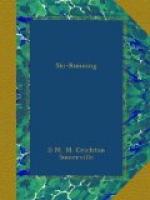Secondly, that we should treat the inhabitants of the country with as much courtesy as possible. The peasant, over whose land we run, makes very little out of the tourist business and has other things to think about rather than sport. He is usually courteous and friendly and always ready to help us when in difficulties. Let us return his hospitality be treating him with courtesy. School teachers have told me that they have great difficulty in persuading the children to greet foreigners because these so seldom respond. Yet few things are more pleasant than the friendly “Gruesse,” or “Gruess Gott,” or “Leb wohl,” with which one is greeted by the people of the country. We can answer in English if we do not know how to answer in German, but do let us answer and, thereby, prove ourselves as friendly as our hosts.
Another matter, which is not always understood by beginners on the snow fields is that when an Alpine Club or local Ski Club hut is used, a fee should be paid to the funds which support the Hut. These Huts are expensive to build and their upkeep is a great tax on the Clubs. British runners can either join the local Club, when they can use the Huts by day for nothing, or they can pay the advertised fee for whatever use they make of them.
A notice is always posted in the Hut showing the various charges, but when no one is there to collect the money, it is left to the honour of the guests to pay it. A money-box can be found in all huts within Switzerland proper, but as these boxes are not safe from marauders near the frontier, the Ski runner has to send the money in by post. At the Boval hut, for instance, above the Morteratsch Glacier, a supply of money order forms will be found hanging near a door. All the leader of the party has to do is to collect the money from his members, take one of the forms and pay the money into any post office, whence it is sent to the H.Q. of the Club.
Huts should invariably be left tidy. This also is a matter of honour. The doors are unlocked always in order that people who may need hospitality, in case of distress, can find shelter. Blankets can be borrowed. Wood is usually provided for firing and there may even be a reserve of food, all of which should be respected. Before the party leaves, blankets should be folded, shutters should be shut, snow swept out and debris buried outside, or what can be used as fuel put away tidily in the kitchen. Then the door should be shut carefully and the hut left the better, rather than the worse off for having given hospitality.
SNOW AND LIGHT
Full descriptions of the different types of snow which must be negotiated by the Ski-runner will be found in Mr. Arnold Lunn’s book, “Alpine Ski-ing.”
It is only necessary for me, therefore, to describe the four main types, namely, soft, hard, crust and sticky snow.
Soft snow in winter is the new powder snow, which is to be found after a fall or on North slopes where sun and wind have not spoilt it. It is the ideal snow for the luxurious runner, especially two days after it has fallen, when it has settled down and a hard frost has converted it into crystal powder. A run through crystallized snow, which tinkles as the Skis cut through it, is beyond description.




